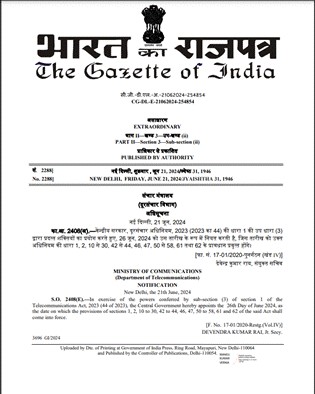Union Government on 21.06.2024, issued Gazette Notification for enforcing sections 1, 2, 10 to 30, 42 to 44, 46, 47, 50 to 58, 61 and 62 of the Telecommunications Act, 2023.
Link of the Gazette Notification given below:

The Telecommunications Act, 2023 aims to amend and consolidate the law relating to development, expansion and operation of telecommunication services and telecommunication networks; assignment of spectrum and for matters connected therewith. The Telecommunications Act, 2023 also seeks to repeal existing legislative framework like Indian Telegraph Act,1885 and Indian Wireless Telegraph Act, 1933 owing to huge technical advancements in the telecom sector and technologies.
Guided by the principles of Samavesh (Inclusion), Suraksha (Security), Vriddhi (Growth), and Tvarit (Responsiveness), the Act aims to achieve the vision of Viksit Bharat (Developed India).
The Telecommunications Act, 2023, was passed by the Parliament in December 2023, received the assent of the President of India on 24.12.2023 and was published in the official Gazette on 24.12.2023.
The salient features of the sections that have been brought into force with effect from 26.06.2024:
- Definitions: The Telecommunications Act clearly defines various terminologies related to the implementation of the Act thereby reducing uncertainties and improving investor confidence and is a step towards ease of doing business.
- RoW framework: Right of Way provides for effective RoW framework, both on public and private property. The definition of public entities has been broadened to include government agencies, local bodies and PPP projects like airports, seaports, and highways. Public entities shall be obligated to provide right of way except in special circumstances. The fee for right of way would be subject to a ceiling. The Act provides complete framework for RoW in respect of private property based on mutual agreement. The Act also provides that the RoW to be granted shall be non-discriminatory and as far as practicable on a non-exclusive basis. It also provides that telecommunication infrastructure shall be distinct from the property it is installed on. This will help reduce the disputes when property is sold or leased.
- Common ducts: In line with PM Gati Shakti vision, the law provides for Central Government to establish common ducts and cable corridors.
- Telecommunication standards: Telecom is a global industry. To ensure national security and promote India’s technology developers, the Act lays down powers to set standards and conformity assessment measures for telecommunication services, telecommunication networks, telecommunication security, etc.
- National Security and Public safety: The Act provides strong provisions to take necessary measures for national security and public safety.
- Inclusive service delivery, Innovation and technology development: The Act expands the scope of Universal Service Obligation Fund to include supporting universal services in underserved rural, remote, and urban areas; supporting research and development of telecommunication services, technologies, products and pilot projects. The Act also provides legal framework for Regulatory Sandbox to facilitate innovation, and deployment of new technology.
- Protection of users: Telecommunication is a powerful tool for empowerment of masses. However, it can be misused to cause harm to users. The Act provides measures for protection of users from unsolicited commercial communication and create a grievance redressal mechanism.
- Digital by design: The Act provides that the implementation shall be digital by design bringing online dispute resolution and other framework.
In order to ensure efficient transition, the notification has also enforced section 61 and 62 which will provide continuation to the existing framework till rules are made under the new law, thus providing a conducive and friendly environment to the business and the sector.
 Matribhumi Samachar English
Matribhumi Samachar English


